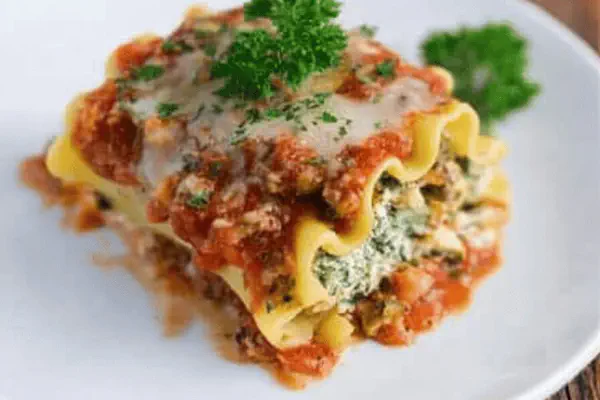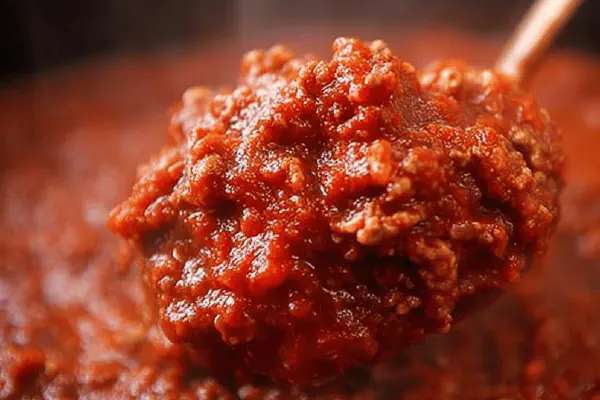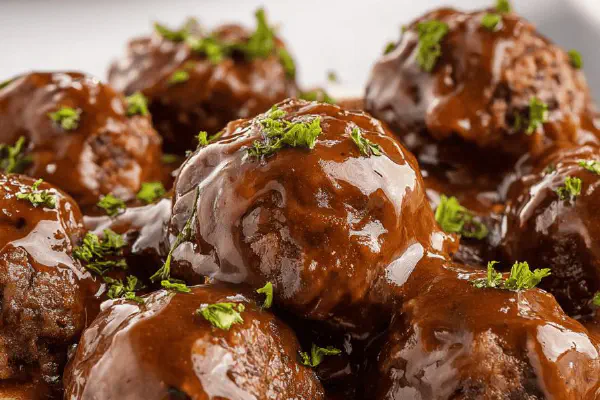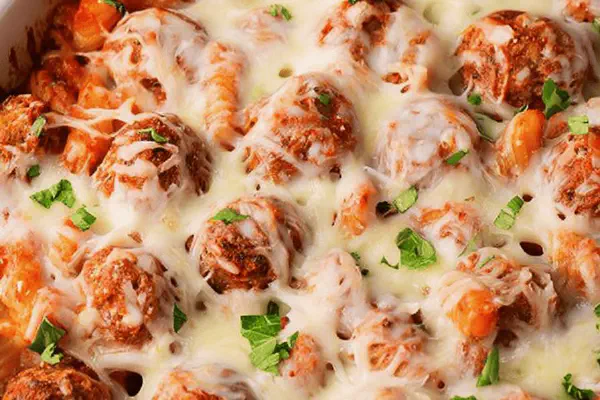Large Italian Meatballs
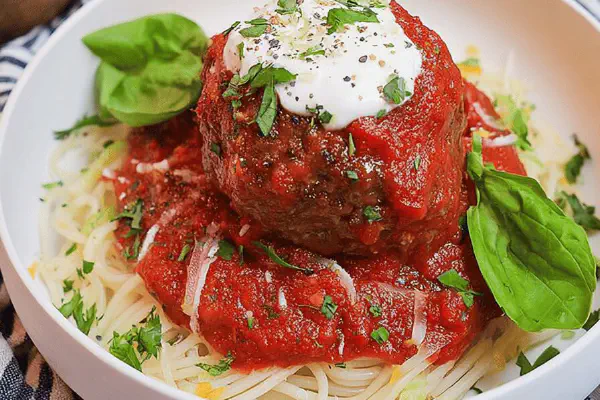
By Emma
Certified Culinary Professional
Ingredients
- 3 slices rustic country bread, crust removed, cubed
- 3/4 cup whole milk
- 1 tbsp olive oil
- 1/2 cup finely chopped onion
- 3 cloves garlic, minced
- 1 tsp kosher salt
- 1/2 tsp black pepper
- 2 large eggs
- 1/2 cup grated Parmigiano Reggiano
- 1/3 cup dry breadcrumbs
- 1/4 cup chopped fresh flat-leaf parsley
- 1/4 cup chopped fresh basil
- 1 lb ground beef and pork blend (or swap ground veal for pork)
- Salt and pepper to taste
- 2 cups marinara sauce (homemade or good quality jarred)
- 1 cup whole milk ricotta
- Extra parsley or basil for garnish
About the ingredients
Method
- Cube bread, soak in milk about 10 minutes until soft. Then squeeze out excess milk well but keep the soaked bread; need moisture, not soggy mush.
- Heat olive oil in skillet over medium. Toss onions and garlic in gently. Stir salt and pepper in, cook until onions turn translucent and smell sweet, about 3-4 minutes. Remove from heat immediately to avoid bitterness. Let cool slightly.
- In large bowl, whisk eggs lightly with Parmigiano, dry crumbs, parsley, basil. Add bread and cooled onion mixture. It thickens to a sticky paste.
- Add ground meat mixture, break it apart as you add so no clumps. Use your hands, fold gently but completely. Overworking toughens protein. Form large ball. Divide into three equal portions.
- Shape each portion into a big meatball by rolling between hands, press gently to compact. Should be firm but springy. If too wet, dust lightly with crumbs but avoid drying.
- Place meatballs on plate, cover with plastic wrap. Refrigerate minimum 1 hour, can do overnight. Rest lets flavors meld, meat firms, prevents crumbling during cooking.
- Oven to 350F. Remove meatballs, toss gently if surface cracked. Arrange in cast iron or ovenproof dish, 2 inches apart so heat circulates. Bake about 30 minutes. Look for browned edges; meat starts firming up but not dry.
- After bake, skim excess fat/oil with spoon. Spoon marinara sauce over meatballs liberally. Return to oven simmering gently with sauce for another 30 minutes or until internal temp hits 140F. Sauce thickens slightly on edges, aroma is rich tomato-herb.
- Pull from oven, let rest 10 minutes uncovered. Resting lets juices redistribute, meatballs hold shape when cut.
- While meat rests, whip ricotta in bowl or stand mixer on low with whisk attachment until it’s fluffy and smooth, air incorporated. Gives creaminess and light texture contrast.
- Serve meatballs topped with big dollops of chilled whipped ricotta. Sprinkle fresh parsley or basil on top for snap and color. Great as main with crusty bread or spooned over pasta.
- Pro tip: If meatballs fall apart, likely bread not squeezed enough or meat too wet. If sauce too thin, simmer longer uncovered before returning meatballs in. Work quickly once eggs added to avoid tough texture.
- Try swapping pork for ground veal to lighten flavor. Sometimes I add a pinch of fennel pollen or red pepper flakes for a subtle heat and aroma kick.
Cooking tips
Chef's notes
- 💡 Bread soak not just soak but squeeze. Too wet and meat slips apart, too dry loses tenderness. I learned to press shield keeps juiciness but no mush. Rustic day-old bread best; fresh bread ruins firm bite. Milk must be whole, fat keeps fat beneath surface. It’s texture control, no compromise.
- 💡 Onion and garlic heat timing critical. Medium oil temp only; high burns quick bitter. Stir often, watch edges turn translucent with aroma shift from sharp to sweet. Remove heat fast or risk lingering burnt flavor. Let cool before mixing or cooks eggs too fast; texture wrecked, rubbery.
- 💡 Egg whisking is dance. Light whisk not heavy beating; swollen proteins toughen inside. Combining Parmigiano and herbs with eggs forms binder. Add dry crumbs after little at a time—too wet and balls collapse, too dry crumb overload kills moisture balance.
- 💡 Folding in meat slow, careful. Hands work best; no electric mixers. Break clumps with fingertips, fold gently to trap air. Overmix crushes meat fiber, tough chew ahead. Form large balls then divide to avoid dense crunch. Some crust after bake seals interior juices.
- 💡 Rest in fridge mandatory. Minimum an hour but overnight better. Chilling firms up exterior fat, proteins settle tension inside. Skipping rest often leads to crumble mess when cooking later. Cold balls handle bake heat without falling apart or shrinking too much.
- 💡 Oven set steady 350F. Arrange meatballs spaced apart so air circulates heat evenly. Watch for browned edges not dark spots. Bake 30 min then skim fat off pan to avoid greasy sauce. Sauce finish cooks gently, steams meatballs internally, locks flavor without drying.
- 💡 Whipping ricotta needs cold temperature, low speed. Air folds in slow to keep fluff, don’t whip hard or it breaks down into grainy. Texture contrast critical here; cold ricotta temp drops the warm meatball bite, makes dish multidimensional in mouthfeel.
- 💡 If meatballs collapse during cooking check bread moisture level first. Too much milk soaked drains away binding power. Also avoid overmixing protein strands or add a bit more dry crumbs next time. Sauce thinning fixes by simmering uncovered longer before adding balls back in.
- 💡 Swap pork for veal to lighten flavor profile. Veal softer texture, less fat but needs careful handling not to dry. Adding fennel pollen gives subtle anise note but keep it light or it overpowers. Red pepper flakes scattered if wanted some heat, spice balance key here.
Common questions
Why do meatballs fall apart?
Usually bread soaked wrong or overmix meat. Bread soaked not squeezed enough so water seeps out in cooking. Overworking meat crushes protein, ruins binding. Can fix by adding breadcrumbs or chilling longer before cooking.
Can I use different meat?
Sure, swap pork for ground veal gives lighter flavor, less fat. Beef and veal mix different moisture level; veal dries faster so watch bake time. Turkey less fat but needs more binder. Season differently if needed.
How to fix thin sauce?
Simmer without meatballs uncovered. Sauce thickens slow. Watch so it doesn’t burn bottom. Add tomato paste for quick thickening if time short. Saucing after bake helps keep control of final consistency.
Can I store leftovers?
Refrigerate in airtight container 3-4 days. Reheat gently, microwave or oven with lid to keep moisture. Freeze cooked meatballs in sauce separate or combined. Thaw fully in fridge before reheating slow to avoid drying out.
